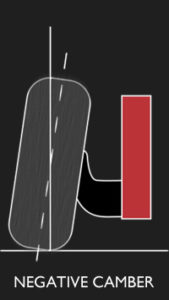What is Wheel Alignment and how does it affect your Car Tyres?
Wheel Alignment is the Measurement of complex suspension angles and the adjustment of a variety of suspension components. It is a suspension-tuning tool which greatly influences the vehicle’s handling and tire wear.
Wheel alignment consists of adjusting the angles of the wheels so that they are parallel to each other and perpendicular to the ground, thus maximizing tire life and ensures straight and true tracking along a straight and level road.
The way a wheel is oriented on your car is broken down to three major components; camber, caster, and toe.
 Camber
Camber
Camber angle is the measure in degrees of the difference between the wheels vertical alignment perpendicular to the surface. If a wheel is perfectly perpendicular to the surface, its camber would be 0 degrees. Camber is described as negative when the top of the tires begin to tilt inward towards the fender wells. Consequently, when the top of the tires begin to tilt away from the vehicle it is considered positive.
If the camber is out of adjustment, it will cause premature tire wear on one side of the tire’s thread. When the camber is out of adjustment it can cause a pulling problem to the side with the more positive camber.
This usually happens when the vehicle has been involved in an accident which has caused structural damage or damage to the strut and / or spindle assembly. Camber also goes out of adjustment when the springs sag and causes ride height to change, or when ball joints and or other attached parts are worn or defective. It also varies depending on speed as aerodynamic forces changes riding height.
On most front-wheel-drive vehicles, camber is not adjustable, however there are aftermarket kits that allow sufficient adjustment to compensate for accident damage or the change in alignment due to the installation of lowering springs.
 Caster
Caster
Caster is a bit harder to conceptualize, but it’s defined as the angle created by the steerings pivot point from the front to back of the vehicle. Caster is positive if the line is angled forward, and negative if backward.
If the caster is out of adjustment, it can cause problems in straight-line tracking. If the caster is different from side to side, the vehicle will pull to the side with the less positive caster. If the caster is equal but too negative, the steering will be light and the vehicle will wander and be difficult to keep in a straight line. If the caster is equal but too positive, the steering will be heavy and the steering wheel may kick when you hit a bump.
Caster has little or no effect on tire wear.
Toe
 Toe represents the angle derived from pointing the tires inward or outward from a top-down view – much like looking down at your toes and angling them inward or outward.
Toe represents the angle derived from pointing the tires inward or outward from a top-down view – much like looking down at your toes and angling them inward or outward.
The vehicle’s toe is the most critical alignment settings relative to tire wear. if the toe setting is just 1/32-inch off of its appropriate setting, each tire on that axle will scrub almost 3 1/2 feet sideways every mile, therefore reducing tire life.
The toe angle identifies the direction of the tires compared to the centerline of the vehicle. Rear-wheel drive vehicle “pushes” the front tires, as they roll along the road, resistance causes some drag resulting in rearward movement of the suspension arms against their bushings. Most rear-wheel drive vehicles use positive toe to compensate for suspension movement.
Front-wheel drive vehicle “pulls” the vehicle, resulting in forward movement of the suspension arms against their bushings. Most front-wheel drive vehicles use negative toe to compensate for suspension movement.
Wheel Alignment should be checked whenever new tires are installed, suspension components installed, when the vehicle has encountered a major road hazard or curb and any time unusual tire wear patterns appear.


0 Comments